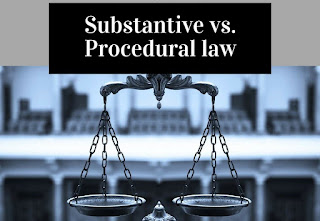This article covers the concept
of Substantive and procedural laws including its meaning, evolutionary
perspective and distinction of the both
1. MEANING
Substantive law and procedural
law are two fundamental branches of law that govern different aspects of the
legal system. Let's take a closer look at each of them:
i) Substantive Law:
Substantive law refers to the
body of laws that define and regulate the rights and obligations of individuals
or entities in society. It sets out the rules that determine how people should
behave, what actions are considered legal or illegal, and the consequences for
violating those rules. Substantive law governs various areas, such as criminal
law, contract law, property law, tort law, family law, and so on. It
establishes the rights and duties of individuals and provides the legal
framework for resolving disputes and seeking remedies.
For example, in criminal law,
substantive law defines specific criminal offenses, such as murder, theft, or
fraud, and outlines the elements that must be proven to establish guilt. It
also establishes the range of penalties for each offense. In contract law, substantive
law sets out the rules for creating a valid contract, determining the rights
and obligations of the parties involved, and specifying remedies for breach of
contract.
ii) Procedural Law:
Procedural law refers to the
set of rules and processes that govern the conduct of legal proceedings. It
outlines the methods and steps to be followed when enforcing substantive rights
or resolving legal disputes. Procedural law ensures that legal proceedings are
fair, consistent, and efficient. It governs matters such as jurisdiction, court
procedures, evidence, appeals, and enforcement of judgments.
Procedural law provides the
framework for how legal cases are initiated, conducted, and ultimately
resolved. It sets out the rules of evidence, the requirements for presenting a
case, and the standards for proving or disproving allegations. It also
regulates the conduct of participants in legal proceedings, including lawyers,
judges, and witnesses.
For example, in a criminal
trial, procedural law determines how the trial should proceed, from the
selection of the jury to the presentation of evidence, examination of
witnesses, and the closing arguments. It ensures that the defendant's rights,
such as the right to a fair trial, the right to legal representation, and the
right to challenge evidence, are protected.
In summary, substantive law
defines the rights and obligations of individuals and entities, while
procedural law governs the process by which those rights and obligations are
enforced and disputes are resolved within the legal system. Both branches are essential
for maintaining a fair and just legal framework.
2.
EVOLUTIONARY PERSPECTIVE OF SUBSTANTIVE AND PROCEDURAL LAWS
The
evolution of substantive and procedural laws has been shaped by various
factors, including societal changes, advancements in legal theory, and the
development of legal systems over time. Here is a brief overview of their
evolution:
i)
Evolution of Substantive Law:
Substantive
law has evolved in response to changing societal norms, cultural shifts, and
the need for legal systems to adapt to new challenges. Some key factors
influencing its evolution include:
- Historical Development: Substantive laws have evolved over centuries as societies have sought to regulate human behavior, protect individual rights, and promote social order. Ancient legal codes, such as the Code of Hammurabi or the Twelve Tables of Rome, laid the foundation for many modern legal principles.
- Legal Philosophies: Different schools of legal thought, such as natural law, positivism, and legal realism, have influenced the development of substantive law. These philosophies have shaped debates over the nature of rights, justice, and the proper role of law in society.
- Statutory Changes: Legislative bodies play a crucial role in shaping substantive law by enacting new laws, amending existing ones, or repealing outdated statutes. As society evolves, new legislation is often introduced to address emerging issues, technological advancements, or changing social values.
- Judicial Precedent: Court decisions and the development of case law have also contributed to the evolution of substantive law. Courts interpret statutes, resolve legal disputes, and establish legal principles through their judgments. Landmark cases often set new precedents that shape future legal interpretations.
ii)
Evolution of Procedural Law:
Procedural
law has also undergone significant changes throughout history, driven by the
need to ensure fair and efficient legal processes. Some factors influencing its
evolution include:
- Due Process: The concept of due process has been a driving force behind the development of procedural law. It emphasizes the importance of fair treatment, notice, and the right to be heard in legal proceedings. Over time, due process rights have expanded to provide greater protections for individuals involved in legal disputes.
- Access to Justice: The evolution of procedural law has aimed to improve access to justice for all individuals, regardless of their social status or economic means. Reforms in procedures, such as the introduction of alternative dispute resolution methods, simplified court processes, and legal aid programs, have been implemented to enhance access to justice.
- Modernization and Efficiency: Procedural law has adapted to modern challenges and advancements in technology to improve the efficiency of legal processes. Electronic filing, online dispute resolution, and other technological innovations have been integrated into procedural rules to streamline proceedings and reduce delays.
- Judicial Administration: Procedural law has also been influenced by considerations of judicial administration. Rules and procedures are designed to ensure the effective functioning of courts, case management, and the timely resolution of disputes.
Overall,
substantive and procedural laws continue to evolve to meet the changing needs
of society, ensure fairness, and promote the effective functioning of legal
systems. Legal reforms, court decisions, and societal developments play crucial
roles in shaping these branches of law.
3.
DIFFERENCES BETWEEN SUBSTANTIVE LAW AND PROCEDURAL LAW
Substantive law and procedural
law are two distinct branches of law that serve different purposes and govern
different aspects of the legal system. Here are the key differences between
substantive and procedural laws:
a) Nature and Purpose:
- Substantive Law: Substantive law defines the rights, duties, and obligations of individuals or entities. It establishes the rules and principles that govern various legal issues, such as criminal offenses, contracts, property rights, and torts. Substantive law focuses on the substance or content of the law and determines what is lawful or unlawful.
- Procedural Law: Procedural law, on the other hand, outlines the process and methods by which substantive laws are enforced, rights are protected, and legal disputes are resolved. It sets out the rules and procedures that must be followed in legal proceedings, including matters like jurisdiction, evidence, court procedures, and appeals. Procedural law ensures that legal proceedings are fair, orderly, and efficient.
b) Focus:
- Substantive Law: Substantive law focuses on the substance or content of the law. It deals with the rights, obligations, and legal principles that govern specific areas of law. Substantive law determines what individuals can and cannot do, and it establishes the consequences for violating those rules. It answers questions about what actions are legal, what rights individuals possess, and what remedies are available for violations.
- Procedural Law: Procedural law focuses on the process by which legal rights and obligations are enforced and disputes are resolved. It deals with the methods, rules, and procedures that must be followed in legal proceedings. Procedural law ensures that legal cases are initiated, conducted, and resolved in a fair and consistent manner. It answers questions about how legal actions are commenced, what steps are taken during a trial, how evidence is presented, and how judgments are enforced.
c) Application:
- Substantive Law: Substantive law applies to specific areas of law and governs the rights and obligations of individuals or entities. For example, criminal law defines crimes and their penalties, contract law governs the creation and enforcement of contracts, and property law establishes rules for ownership and use of property.
- Procedural Law: Procedural law applies to the process and procedures followed in legal proceedings, regardless of the substantive legal issue involved. It provides the framework for how cases are initiated, conducted, and resolved within the legal system. Procedural rules apply to areas such as jurisdiction, filing lawsuits, presenting evidence, examining witnesses, and appealing court decisions.
d) Consequences of Violation:
- Substantive Law: Violation of substantive law can result in legal consequences, such as criminal charges, civil liability, or the loss of certain rights. The violation of substantive law typically leads to the imposition of penalties, remedies, or damages, depending on the specific area of law and the nature of the violation.
- Procedural Law: Violation of procedural law may result in the dismissal of a case, exclusion of evidence, or the denial of certain procedural rights. Procedural violations can affect the fairness and integrity of legal proceedings and may lead to the reversal of judgments or the need for a new trial.
Substantive law defines the
rights and obligations of individuals or entities, while procedural law governs
the process and methods by which those rights and obligations are enforced, and
legal disputes are resolved. Substantive law focuses on the content of the law,
while procedural law focuses on the process of applying the law.


.png)

.png)

No comments:
Post a Comment